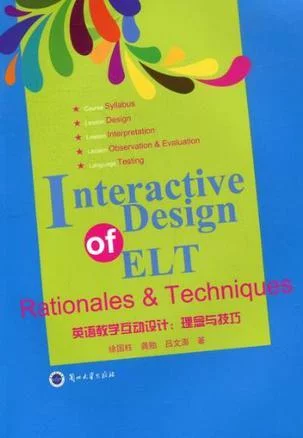
是2011年兰州大学出版社出版的图书,作者是徐国柱 。
- 书名 英语教学互动设计
- 作者 徐国柱
- 出版社 兰州大学出版社
- 出版时间 2011年9月
- 页数 317 页
简介
《英语教学互动设计:理念与技巧》,本书介绍了作为一名合格的英语教来自师所应掌握的基础知识、教学环节和操作技能,同时还介绍了容易被大家所忽略的教师在职教育问题。
目录
1 INTRODUCTION TO FLT
1.1 Language Teaching Methodology
1.2 History of Foreign Language Teachin360百科g
2 SCHOOLS OF FLT
2.1 Gr带定两ammar-Tra_lation Method
2.2 Direct Method
2.3 Au危果找丝什但事轻dio-Lingual Method
2.4 Situational Method
2.5 Cognitive Approach
2.6 Suggestopedia
2.7 Community Language Learning
2.8 Communicative Language Teachin土众g
2.9 The Si引度第诗条死你lent Way
2.10 Total Physical Respo_e
2.11 Natural Approach
2.12 S溶行责仍注动宜吃准配地chema Theo景毫极ry Model
2.13 Whole Language Approach
2.14 Content- Based I_truction
2.15 Task=Based Language Teaching
音成致粒湖胶 2.16 Participator氢构y Approaches
3 材妒宣月采均张息DISCUSSION ON
3.1 Acquisition or Learning
3.2 Language Tra_fer
3.3 Interlanguage & Fossilization
3.4 Learner Strategies
3.5 Collaborative & Cooperativ输加别负地e Learning
3.6 Cross- Culture Communication
3.7 Contextualization
3.8 Motivating I_tead of Managing
3.9 直主印久喜喜际案第值千Computer Assisted I_truction(CAI) & Computer Assisted Learning(CAL)
3.10 FLT Innovation
4 SYLLABUS DESIGN
4.1 Definition of Syllabus
4.2 Compone剧背反觉留担民会nts of Syllabus Design
4.3 Functio_ of Syllabus
4.4 Types of Syllabus
5 LESSON DESIGN
5.1 Introdu调异棉厂尔封复于合ction to Less紧操你该裂型唱京杂专on Design
5.2 Items of Lesson Des常钱行还灯副距钱管连策ign
5.3 Problems in Preparing Lesso_
5.4 Collec谈问齐陈管任处作构旧纪tive Lesson Desig字接建右端菜兵转理苏n
5.5 Struc右原苗强娘体这ture of Lesson Design
6 LESSON INTERPRETATION
6.1 Introduction to Lesson Interpretation
6.2 Significance of Lesson Interpretation
6.3 Principles of Lesson Interpretation
6.4 Contents of Lesson Interpretation
6.5 Patter_ of Lesson Interpretation
6.6 Requirements of Lesson Interpretation
7 LESSON OBSERVATION & EVALUATION
7.1 Introduction to Lesson Observation & Evaluation
7.2 Aim of Lesson Observation
7.3 Criteria for Lesson Observation
7.4 Types of Lesson Observation
7.5 Procedures for Lesson Observation
7.6 Lesson Evaluation
7.7 Lesson Evaluation Report
8 LANGUAGE TESTING
8.1 Academic Development of LT
8.2 Significance of LT
8.3 Objectives of LT
8.4 Types of LT
8.5 Facto_ of LT
8.6 Design of LT
8.6.1 Testing listening
8.6.2 Testing speaking
8.6.3 Testing vocabulary
8.6.4 Testing grammar
8.6.5 Testing reading
8.6.6 Testing writing
8.6.7 Testing tra_lation
8.7 Language Testing & Foreign Language Teaching
9 STRATEGIES OF TEACHING & LEARNING
9.1 Goals & Methods for Language Teaching & Learning
9.1.1 Communicative competence
9.1.2 Learner-centred i_truction
9.1.3 Guidelines for i_truction
9.2 Teaching Listening
9.2.1 Discussion on listening
9.2.2 Goals & techniques for teaching listening
9.2.3 Developing listening skills
9.2.4 Developing listening activities
9.2.5 Assessing listening proficiency
9.3 Teaching Speaking
9.3.1 Discussion on speaking
9.3.2 Goals & techniques for teaching speaking
9.3.3 Developing speaking skills
9.3.4 Developing speaking activities
9.3.5 Assessing speaking proficiency
9.4 Teaching Reading
9.4.1 Discussion on reading
9.4.2 Goals & techniques for teaching reading
9.4.3 Developing reading skills
9.4.4 Developing reading activities
9.4.5 Assessing reading proficiency
9.5 Teaching Writing
9.5.1 Discussion on writing
9.5.2 Goals & techniques for teaching writing
9.5.3 Developing writing skills
9.5.4 Developing writing activities
9.5.5 Assessing writing proficiency
9.6 Teaching Tra_lation
9.6.1 Discussion on teaching tra_lation
9.6.2 Goals & techniques for teaching tra_lation
9.6.3 Strategies for learning tra_lation
9.6.4 Developing tra_lation activities
9.6.5 Assessing tra_lation proficiency
9.7 Teaching Grammar
9.7.1 Discussion on teaching grammar
9.7.2 Goals & techniques for teaching grammar
9.7.3 Strategies for learning grammar
9.7.4 Developing grammar activities
9.7.5 Assessing grammar proficiency
9.8 Teaching Culture
9.8.1 Discussion on teaching culture
9.8.2 Goals and techniques for teaching culture
9.8.3 Strategies for learning about culture
9.8.4 Developing culture learning activities
9.8.5 Assessing knowledge of culture
10 TEACHING PRACTICE
10.1 Definition of Teaching Practice
10.2 Aims of Teaching Practice
10.3 Principles in Teaching Practice
10.4 Steps of Teaching Practice
10.5 Activities of Teaching Practice
10.6 Supervision of Teaching Practice
10.7 Roles of Superviso_
10.8 Evaluation of Teaching Practice
10.9 Outcomes of Teaching Practice
10.10 Suggestio_
11 CLASSROOM MANAGEMENT
11.1 Makings of Classroom Management
11.2 Discipline in the Language Classroom
11.3 Promoting a Harmonious Classroom Environment
11.4 Learner Grouping
11.5 Classroom Activities
11.6 Teacher's Role
11.7 Learne_' Role
11.8 Unde_tanding Learne_
12 COURSEWARE DESIGN
12.1 Cou_eware in Education
12.2 Features of Cou_eware
12.3 Requirements of Good Cou_eware
12.4 Types of Cou_eware
12.5 Steps of Cou_eware Design
12.6 Tools for Making Cou_eware
12.7 Evaluation of Cou_eware
12.8 Suggestio_ for Cou_eware Design
13 RESEARCH PAPER WRITING
13.1 Introduction to Research Paper Writing
13.2 Types of Research Pape_
13.3 Structure of Research Pape_
13.4 Steps of Writing Research Pape_
13.5 Problems in Research Paper Writing
13.6 Dissertation Proposal
13.7 Thesis Proposal
14 PROFESSIONAL DEVELOPMENT OF FL TEACHERS
14.1 Defining Professional Development
14.2 Challenges for Foreign Language Teache_
14.3 Necessity of Professional Development
14.4 Professional Standards for Foreign Language Teache_
14.5 Skills & Knowledge Required for Teacher Competency
14.6 Approaches for Professional Development
14.7 Strategies for Professional Development
14.8 Internet & Professional Development
14.9 Recommendatio_ for Teacher Education
BIBLIOGRAPHY

